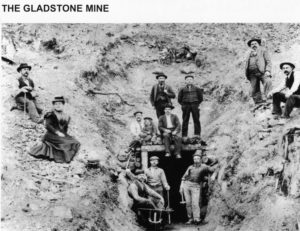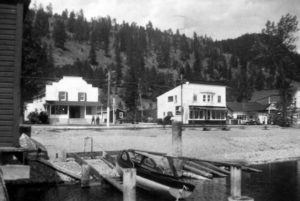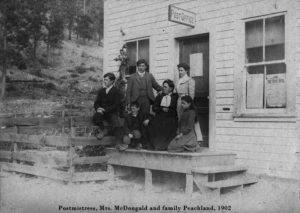History
Discovering Peachland's Past
Not only is Peachland a vibrant and unique tourist destination, it is also rich with history. Its history begins 10,000 years ago as the Okanagan was sculpted into the unique geography that shapes our landscape today. The valley used to be home to an exceptionally large glacier that was up to 3000 meters thick. This was responsible for creating the shape of the valley and Okanagan Lake. Our scenic landscapes and mountain views are all remnants of this geological phenomenon.
The first people to call the Okanagan home are the Syilx/Okanagan people. This territory encompasses 69,000 square kilometers of the Okanagan Valley, reaching into the Washington State. The Syilx people continue to practice their culture. To learn more, we encourage you to visit the sncewips heritage museum, 260-525 Hwy 97. S V1Z 4C9 www.sncewips.com
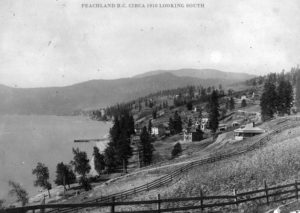
In 1812 European settlers travelled through this area while completing an expedition throughout the Okanagan. In 1884, a man by the name of Charles Lambly began to ranch and grow crops. Peachland was called Lambly’s Landing at the time. It was soon seen in its potential to be a mining town. The first mine in Peachland was called the Gladstone Mine and it was owned by Gus Hewitt, later bought by J.M. Robinson. J.M. Robinson stayed at Lambly’s ranch for some time upon his arrival in Peachland. He was amazed at how well peaches grew at Lambly’s and how delicious they tasted. It was because of those delicious peaches that the town eventually got its name, Peachland in 1898.
After the mining industry faded away, other industries in Peachland came to be. Agriculture was successful; however, logging and forestry soon became the most prolific industry in town. Nowadays, the only sawmill left in the area is Gorman’s mill which is just up the hill in Westbank.
From these industries and humble beginnings, Peachland developed into the beautiful community that it is now. In 1909 Peachland became a municipality. There are still historic buildings and monuments around Peachland that can be seen to this day. We hope as you explore our town you will view the interpretive signs and historic photos and keep these fascinating historical roots in mind.
- Peachland was once a mining town. You can access remnants of the Gladstone mine via the New Gladstone hiking trail. Photo courtesy of Peachland Museum
- View of Beach Ave. from the water. On the left is the Edgewater Inn, now the Edgewater Bar and Grill. Photo courtesy of Peachland Museum
- Peachland’s first post office. Photo courtesy of Peachland Museum
A Historic Tour Of Peachland
A Tour of Peachland:
History Mural
The historic mural, completed in 1999 was a combined project of the Peachland rotary club and the Peachland community arts council.
It was designed by 4 members of the arts council and painted by Robyn Lake, a member of the PCAC. Real residents and one dog are incorporated in the paining.
The PCAC continues to maintain the mural today.
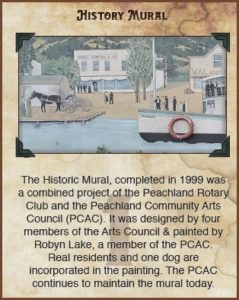
The Baptist Church
The church was built in 1910 at an estimated cost of $1500. At one time, baptisms were held in the lake.
The congregation moved to their new church on 13th street in 1964. Since then it has been the municipal hall, fire brigade hall,
public library, and now the museum. The second floor contains a miniature scale model of the Kettle Valley Railway.
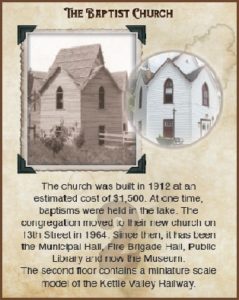
Walters Packing House
Heritage park was the original location of Walters Limited Packing House.
Local orchards provided the fruit that was loaded on to the rail barges to connect to the railway in
Kelowna for their long journey across Canada. It burnt down in 1979.
The park currently features a gazebo built by the Peachland Rotary Club that provides a venue for civic events and a fully accessible lakefront pier,
a collaborative effort by Peachland Lions, Rotary club, and Sportsman association.
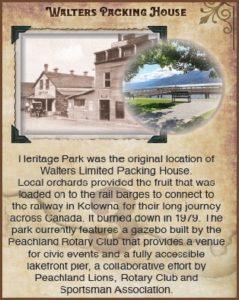
Lakeside Auto & Gas
Built in 1946, Lakeside Auto & Gas was one of 3 gas stations on Beach Ave. Beach Ave was the main highway.
The present highway was built in 1961. Lakeside Auto and Gas is the only known art deco service station in the Okanagan.
It has since become a popular eating place.
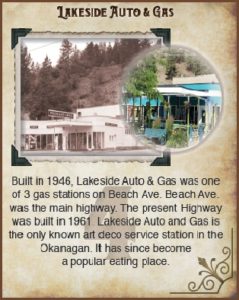
Cenotaph
Of the 23 men who left to serve in WWI only six returned. Four names were added after WWII.
Peachland had the most casualties per capita of any municipality in Canada.
Erected in 1921 the Cenotaph first stood on 2nd street beside the Edgewater Inn. It was moved to its present location in 1976.
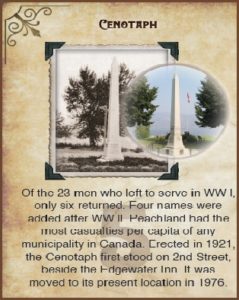
Edgewater Inn
J.M Robertson’s home was built in 1898. Robertson came for the hold and is credited with founding Peachland and giving it the towns name.
Years later the fir tree in front of the building was carved into a totem pole and the establishment was named the totem inn.
It has since been a hotel, post office, and store. Today the Edgewater is a pub and live music venue.
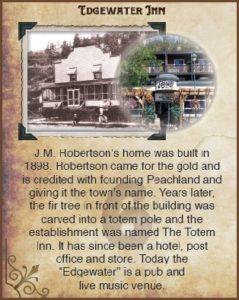
Clements Store & Gas
The store and Imperial Oil Gas Station were built by James H. Clements around 1908.
Mary Clements baked 300 loaves of bread each week in a brick oven behind the store.
They were gone as soon as they were baked! The location has housed many restaurants over the years.
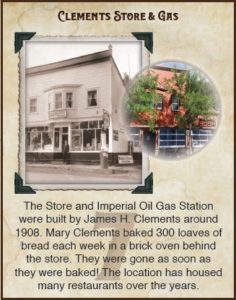
The Methodist Church
Constructed in 1911, the Methodist Church was the first church in Peachland to have a bell tower.
The bell, donated by T.E Eaton company has rung every Sunday since it became the united church in 1925.
Today “The bargain bin” a popular non-profit second-hand store is located on the lower level.
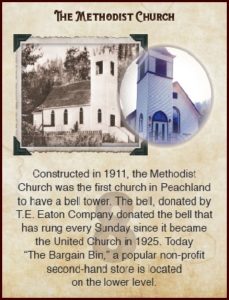
Little School House
The little school house was built in 1898. C.G Elliot was the first teacher in the one room schoolhouse.
In 1908 the student population outgrew the building and a new school was built on Beach Ave.
St. Margaret’s Anglican Church took over the building until it was deconsecrated as a church in 1990.
In 2001 it was renovated by volunteers and currently houses summer art shows & teas winter art workshops and meetings.
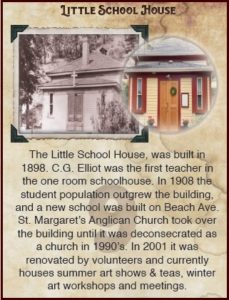
Historic School House
The historic School House was built in 1908. It closed in 2002 and reopened in the fall of 2014 after extensive renovations.
It now houses Our SPACE, which includes the Peachland Art Gallery, Okanagan Folk School, BEEPS, and the Boys & Girls Club.
The attic houses one of BC’s largest maternal bat colonies.
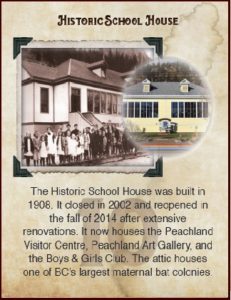
If Ogopogo is real what is it?
Peachland History
Gathering Power
Trepanier Creek saw its first dam, built of wood in 1909, replaced by concrete in 1938. Remains are still visible on the Stave Pipe Hiking Trail
Laundry Service
It’s 5:30am on Washday Wednesday as we call it. I have only 3 hours before the power is cut. I won’t have another chance for power until four o’clock this afternoon when they open the dam again. We have until midnight but..
Before, we had an extra two hours of power on Washday Wednesday, but now that’s gone. I pay extra to use my iron and they’re telling me how many lights I can use in my own home! I Try to avoid some of my water and power fees but they say I have to pay because money helps repay the town’s government loan.
1909 – The township of Peachland was incorporated as a municipality in order to secure a debenture from the provincial government for the construction of a power system diverting approximately 50% of dam water to a reservoir through a wire-bound wooden pipeline.
1916 – The popularity of electric irons caused a strain on Washday Wednesday; the extra daytime hours of power were cut, and a monthly fee of 25 cents was applied to electric iron users.
1922 – Half day power cuts helped satisfy the growing demand for power and reduced strain on the plant
1942 – Extensive work was required to maintain and upgrade the overburdened plant; however, funding was unavailable due to delinquent tax payments
1945 – The provincial government created the BC power commission to acquire small utilities extending electrification in rural areas, building or modernizing both generating plants and transmission systems.
1947 – Peachland taxpayers voted 100 – 1 to sell the power systems to the BC power commission
Gathering Peaches
Many worked as loggers in winter and orchardists in the summer making logging and the fruit industry complementary partners.
Many Yellow Pine trees needed to be cleared for the orchardists to plant the fruit trees. The Pine logs were then used to build the orchardist homes and years later when the fruit began to grow, raw material was used to build boxes for packing and shipping.
Lambly Ranch
It’s 1887, and we are the Lamby Brothers rounding up horses and cattle on our settlement. We found this quiet, flat piece of land and built our home; were the only ones here as far as the eye can see. We planted 5 acres of fruit trees, our favorite being peaches. While we wait a couple of years for the trees to bear fruit, we are wondering what will become of this land…
1887 – The Lambly brothers built the first home in the area which became known as Lambly Landing, located beside Trepanier Creek.
1889 – The commission of Lands and Works was established in Victoria BC, dividing out blocks of land accompanied by an official title; this was the beginning of early settlement in Peachland.
1890 – JM Robinson visited Lambly Ranch. He purchased the adjacent land and formed the Peachland townsite company limited, naming the area Peachland.
1898 – JM Robinson laid out the townsite and sub-divided the land into 10 acre parcels; they were easier ti sell than mine claims.
1905 – The first packing house in the area was built on lake Okanagan
1955 – The packing house closed its doors and was later forced into bankruptcy
1979 – The packing house burnt to the ground after deteriorating badly over the years. Many boasted they’d rid the town of the old eye-store but there was no proof. The mystery is still unsolved.
WHERE ARE THE PEACHLAND PEACHES?
The winter of 1949 to 1950 was devastating for the orchardists with spring temperatures dropping to -40 degrees, causing the lake to freeze over and wiping out the peach trees; other tree fruits suffered heavy damage as well. While locals enjoyed ice skating across the lake, it meant disaster for both the growers and the packing house.
Gathering Timber
Logging became the first sustainable industry in Peachland with five mills operating until the early 1970s
Trees of the Region
When the first pioneers settled in the area the hills of Peachland were covered in mature ponderosa pine and Douglas fir trees. IT was not uncommon to also find jack pine, cottonwood, birch, maple, and cedar trees
Billy Miller
The names Billy Miller and they say I’m a legend, the most famous of Peachland loggers. Don’t know about that but I’m a big redheaded red-mustached man who’s hard to miss. I spend my days in the hills above Peachland. My men and I fell trees, dragging logs to the chutes using teams of horses. I’m proud of how steadily the logs move to the lake down the chutes, many of which I built myself. The logs scream down faster than a hungry cougar!
The first one I built was the drought hill chute in 1912. It carried the heavy Glen Rosa stand to the lake. The logs were hauled to the head of the chute by horses in the summer and sleigh in the winter
Another of my earlier chutes was a mile south of deep creek near Greta Ranch. This one ended on a high bank above the road. THe logs travelled with such momentum they shot high in the air across the rutted lakeshore road ending in the lake with a mighty splash!
I’m most proud of my chute just south of Deep Creek. It’s the longest and most spectacular! She runs over a mile long (1.6km) crossing the road at antlers beach. There’s little traffic on the road in 1922 but about 4 to 6 cars bounced down into the chute rut and out again each day, and one can often see a blue trail of smoke from the head generated by those logs burling down that chute. Sand is used to slow up logs on the fast places and tallow or good old animal fat saved by our wives to speed up the pace when they slow. It’s a wonder to See!
Sawdust
It’s 1899 and two of us had another hard day working with the pit saw making planks for flooring. It was down in the put pulling down on the saw getting covered in sawdust while up top my partner was straining to pull the saw back up. That’s how some of us got our names like Hugh “sawdust” McDougall who introduced our first portable sawmill
Dangers of Logging
Though logging and sawmills were the most booming industry in Peachland they were not without danger. Men were run over by their own loads, mauled by runaway saws in mills and of course some would often lose their fingers.
Charlie Pope
Such was the case with me, Charlie Pope, I was tending to one of those more modern bladed machines when I was soon without my right index finger. Upon recovering I was showing the guys how the accident happened and all of a sudden my left index finger was gone too! True Story!
1900 – Hugh McDougall Sawmill built at the site of camp Hewitt Wharf
1905 – Lee Mills Sawmill Co. LTD near garnet valley dam
1942 – Dan C. Cousins Sawmill on Trepanier Bench
1943 – Dell and Witt purchased Dan C. Cousins Sawmill on Trepanier Bench
1944 – Peachland Sawmill and Box company was built by “Tiny” Dell and Neil Witt
1954 – Peachland Sawmill and Box Company was sold
1958 – Peachland Sawmill and Box Company was closed
1945 – Trautman-Garraway Mill
1955 – Trautman-Garraway Mill became Simpson’s sawmill and then Crown Zellerbach, the largest sawmill in Peachland history.
Gathering Minerals
Pincushion Mountain: The Promise of Gold
Hi, I’m J.M Robinson, a former newspaper man, teacher, and MLA from Manitoba. My wife and I rode pack horses into the Okanagan looking to do a bit of prospecting on our holiday. Were loaded with mining gear and have fallen in love with the area. I recently spoke with clairvoyant Mrs. Gillespie, a psychic who uses mineral psychometry to divine the best placement for a mine. I believe she will help me strike it rich.
It’s spring and we’re here at Gladstone Mine. We’ve Stockpiled gold over winter and it’s time for rawhiding. We have to pile the ore and tie it in raw cowhide, load the packhorses, and drag the lot down to the wharf. We’ve blessed our rock and tunneled in by hanging for 100 feet! We hope this works out.. It’s been hard.
Headwaters Lake: The Promise of Silver
JM Robinson here again. We are up in the hills near Headwaters Lake. I’ve purchased Silver King Mine. It has a tunnel that is 165 feet long with a vertical shaft at the end, the longest tunnel of these times, so I think this is going to be my chance to make it big!
Trepanier Creek: The Promise of Copper
Hi, I’m Bob Bechtel. I’ve reclaimed the Copper King Mine that’s been abandoned for 10 years! The prospectors before me tunneled about 185 feet along a 12 inch vein of chalcopyrite-molybdenum hoping to find gold or silver. They didn’t realize the value of low grade ore, molybdenum and abandoned the site in 1944, overlooking a golden opportunity! It’s going to take some convincing but I know this ore has grand potential…
A Lost Mine: The Promise of Gold
Many have tried to find a gold mine supposedly located on the mountain across from Peachland, but no one has had success.. Read on to hear the tale..
“Lost Gold Mine” Near Peachland Rouses Interest. Story that has become almost legendary is revived again! Peachland BC August 27, 1935
During the early mining years Leon D. McArtner discovered a rich find of ore across from Peachland on Okanagan lake. Marking the location with a pile of stones and fixing the proximity of their location to the town in their minds they returned home to tell of this rich find. Although many efforts were made to locate this site again, all were met with ill success… later there were reports of a Swedish prospector finding the markings made by Mr McCall and his partner but he in turn lost them and could not trace his way back to the place he had found.
At another time, firefighters working in the area his shovels to be retrieved later but could not find them.. With the steep ravines, rough country and an abundance of rattlesnakes the region is practically inaccessible… but perhaps…
The Eleven Mines
Molybdenum, copper: Brenda Mines, 1970: Operational for 20 years. Successful
Gold: Gladstone mine: 1887, south side of pincushion mountain
Silver: Silver King Mine, Silver Queen Mine: 1888 located 9 miles apart on Glenn Robinson Mountain
Molybdenum, low grade ore, Copper king mine 1927 and Iron Horse Mine: Near the dam at Brenda Lake, Abandoned in 1944 after tunneling 185 ft, no success!
Copper, Silver, Gold, Bluebell Mine: 1934 near Lookout Mountain, tunneled in 6o0 feet
No Ore: Derby Gypsy Mine: 1934-1935, 60 feet into the side of a knoll of land. No success
Gold, Silver: Brinson Mines: Silver Lakes & Wilson Mountain. 1930’s up to 5 men working on 4 mine shafts and tunnels. Successful.
No Ore: Dandy Mines: Spring creek area, 150 foot deep tunnel, flooded. No success.
Magnetite, Kathleen Mines: near Glen Lake at Thirsk Road, early 1900’s and 1960 15 foot tunnel, magnetite (magnetic iron)
1887 – The first record of mining activity at camp Hewitt mining & Development company
1888 – J.M Robinson formed the Canadian and American Gold Mining Co. and purchased Camp Hewitt Mining, renaming it Gladstone Mine
1901 – G. Hewitt built a wharf at the present day junction of Renfrew Road and Hwy 97 to ship gold ore to Tacoma, Washington for Smelting – Logging, sawmills and agriculture all contributed to the upcoming vibrant community along with mining
1970 – Brenda Mine created the largest population growth in Peachland, but a capital outlay of $63.5 million was required to begin operation. A Substantial long term benefit to Peachland from Brenda Mine was increased capacity for water storage
1990 – Brenda Mine ceased production
Thomas Shorts
I’m Captain Thomas D. Shorts operating a ferry service aboard my 22-foot rowboat, the Ruth Shorts. She can carry 2.5 tons and boasts a small sail. In good weather the round trip from Okanagan Landing to Penticton, 75 miles each way, takes about 9 days. My freight transport is steady, but I can carry only one paying passenger per month.
I have finally saved enough to invest in a 35 ft steamship, the Mary Victoria Green bow! No more rowing for me; this beauty is powered by an oil fired steam engine. Well, it’s my first trip but I’ve run out of fuel only halfway to Penticton! Now to have to borrow kerosene from cabins along the way…
1858 – After years of Packhorse trains delivering people and good the first wagons reached Peachland via the steep and rugged Fur Brigade Trail
1883 – Travel by water was the safest and most efficient the sternwheeler fleet grew to include the SS Aberdeen, SS York, SS Okanagan and SS Sicamous
1892 – The SS Sicamous and SS Okanagan CPR spur line connected Vernon to the north and Penticton to the south, including telegraph service
1906 – The first car arrived in Peachland by following the original Fur Brigade Trail of 1858
1914 – SS Naramata, a CPR launched steam tug pushed barged and broke ice on Okanagan Lake
1926 – The MV Kelowna, a CNR launched gas powered vessel was the first of its kind on Okanagan Lake
1936 – Steamships were joined on the lake by an increased presence of tugs and barges
1958 – Okanagan lake Bridge opened, connecting Hwy 97 to the north and south, replacing the revered steam wheelers and allowing for increased vehicle transportation
Highway 97
In 1953 highway 97 – The former Beach Ave – was completed, becoming the longest continuous highway in Canada at 2081 kilometers in length, running from the US border to the Yukon. Highway construction had to contend with the local formidable barriers, known as “the bumps” , large, solid, rocky outcroppings rising from the lake.
The Fur Brigade Trail
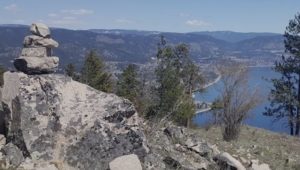 Over 100 years ago, this trail was used by fur traders to transport their goods from Peachland to Summerland and back. You can still see parts of the old irrigation flumes used to transport water from creeks and springs on the mountain down into the orchards and farms.
Over 100 years ago, this trail was used by fur traders to transport their goods from Peachland to Summerland and back. You can still see parts of the old irrigation flumes used to transport water from creeks and springs on the mountain down into the orchards and farms.
Discover this 7.9-km out-and-back trail near Peachland, British Columbia. Generally considered a moderately challenging route, it takes an average of 2 h 40 min to complete. This is a popular trail for hiking, mountain biking, and off-road driving, but you can still enjoy some solitude during quieter times of day. The trail is open year-round and is beautiful to visit anytime. Dogs are welcome, but must be on a leash. – Alltrails.com

